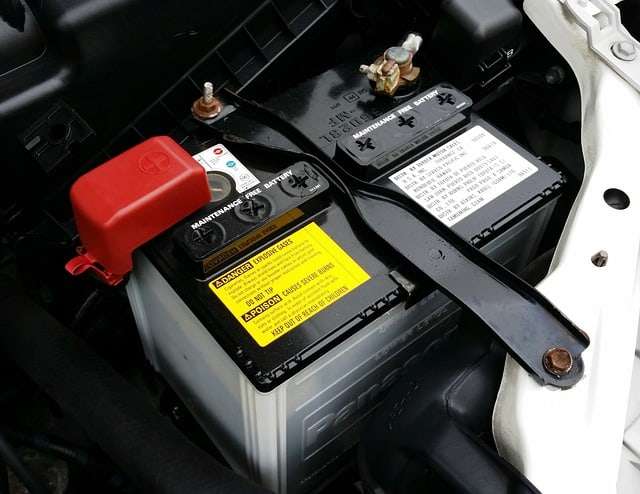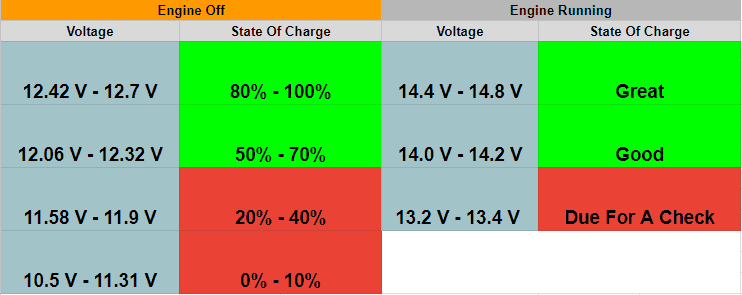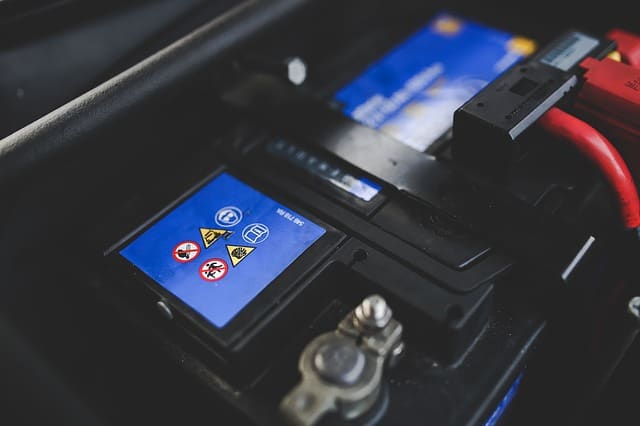Last Updated on October 25, 2023 by Chase Manhattan
Checking your car battery’s voltage is something that should be done preemptively, not something you do when you find yourself with a dead car running late for work.
When testing a car battery with a multimeter, the car battery voltage should have readings of 12.6 Volts or higher. If the car is running, the car battery voltage should measure between 13.7 to 14.7 volts. If the battery has low voltage – 12 Volts or below, it is likely that the battery will keep dying after being completely discharged when trying to start the car.
Quick Navigation
What Voltage Is A Car Battery

In short, car batteries are typically 12v (12 volt) units. This voltage will increase when the car is running, but should typically have 12.6 volts of resting voltage.
The multimeter will show the current voltage reading from the car battery. No matter the type of car battery, a healthy car battery charges at 12.6 Volts or higher. When the car is running, the battery should be charging somewhere between 13.7 Volts – 14.7 Volts.
[Related Article: How Long Does A Car Battery Last]
Car Battery Voltage Chart

This chart will help you read multimeter measurements better. Ideally, you want your car battery to always be at 80%-100% charge. That means the car battery readings you are looking for are 12.42 V – 12.7 V when the engine is not running. [Source]
Weaker readings are acceptable only if you forgot your headlights on. Or, theres freezing cold weather and you haven’t started your car in a while. However, once you go for a drive, and the battery charges up. The state of charge should go back 80% – 100% with a turned-off engine.
Keep in mind, 10.5 V is the minimum voltage needed to start the car. So, your car battery can be at 0% status charge but still start.
When the engine running, the multimeter readings will tell you whether the charging system and alternator is operating properly. With the engine running, 14.0V – 14.8V measurements are acceptable. Readings like 13.2 V – 13.4 V means your car battery should be checked out. Anything below that means you need to change the battery.
How To Test Car Battery Voltage
Checking whether your car battery is working properly is an easy task that any car owner can do. You don’t need to know anything, you just need a measuring device, a multimeter. This simple device measures the voltage of a car battery. Alternatively, if you have it available to you, a load test is a reasonable way to test a car battery’s voltage.
Before your test, make sure that your battery terminals are free from corrosion.
To test your car’s battery voltage, you will connect a multimeter to the negative terminal, then the positive terminal. You will want to make sure that your multimeter is set to read dc volts only.
[You Should Know – Does AutoZone Replace Headlights?]How Many Volts Should A Car’s Battery Have When Running
When the engine is running, healthy car battery voltage reading should be anywhere in the 13.5v – 14.5v range. Within this range, you can be comfortable knowing that your charging system is working correctly. Do note that running voltage can fluctuate as the electrical system is mechanically driven (in this case, the alternator being driven by a belt) and therefore will produce higher or lesser amounts of voltage depending on the speed at which the engine is running.
To get an accurate reading, I recommend you measure car battery’s voltage at idle only. This is when the alternator will be producing the most consistent output.
Car Battery Amps
All car batteries are 12 V batteries, so mix-ups with the voltage can’t happen. What some beginners get wrong are the ampere ratings. These ratings can tell you the capacity of the battery, and how quickly the battery can charge.
Check your owner’s manual prior to making any purchases.
Just like any battery, not just car batteries, the size determines the capacity of the battery. The thing is, the bigger the battery is, the more space there is for cells. Newer car models have bigger batteries but most batteries have a capacity of 550 to 1000 amperes.
The capacity of the battery is not that important though. What matters when choosing a battery are the cranking amps(CA) and the cold cranking amps(CCA). These amp ratings tell you how easy it is to crank the engine.
The CA tells you how many amps the battery can deliver in 30 seconds at a temperature of 32° F. The CCA tells you many amps the battery can deliver in 30 seconds at a temperature of 0° F. [Source]
It depends on where you live but most of the time, the cold cranking amps are more important. If the CCA is high, then the battery can crank the engine easily even in freezing temperatures.
Car Battery Ampere Hours Ratings
You will also find that the car battery manufacturer lists a chart of the ampere-hours(Ah). These ratings tell you how much amperes the battery can deliver without being charged. For instance, a car battery at 80Ah, 4 amps for 20 hours, or 8 amps of power for 10 hours, etc…
The car battery Ah chart also tells you how the battery capacity deteriorates over time.
[Featured Article: How To Wax A Car With A Buffer]
FAQs
What Voltage Battery Is In A Car?
There may be exceptions throughout history, but newer cars all use a 12volt battery. If in doubt, you can determine this by checking the labeling stickers on the side of your car’s battery.
What Is Good Car Battery Voltage?
Anywhere between 12volts – 13 volts is consider good battery voltage. This can be determined with a car battery voltage test from a load tester, or a multimeter. Keep in mind that auto battery voltages will fluctuate and change if the car is running, so it is best tested when the car is off. If a battery tested below 12 volts, it is recommended to seek a replacement immediately.

